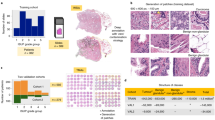Abstract
The diagnosis of prostate cancer is driven by the histopathological appearance of epithelial cells and epithelial tissue architecture. Despite the fact that the appearance of the tumor-associated stroma contributes to diagnostic impressions, its assessment has not been standardized. Given the crucial role of the tumor microenvironment in tumor progression, it is hypothesized that the morphological analysis of stroma could have diagnostic and prognostic value. However, stromal alterations are often subtle and challenging to characterize through light microscopy alone. Emerging evidence suggests that computerized algorithms can be used to identify and characterize these changes. This paper presents a deep-learning approach to identify and characterize tumor-associated stroma in multi-modal prostate histopathology slides. The model achieved an average testing AUROC of \(86.53\%\) on a large curated dataset with over 1.1 million stroma patches. Our experimental results indicate that stromal alterations are detectable in the presence of prostate cancer and highlight the potential for tumor-associated stroma to serve as a diagnostic biomarker in prostate cancer. Furthermore, our research offers a promising computational framework for in-depth exploration of the field effect and tumor progression in prostate cancer.
Access this chapter
Tax calculation will be finalised at checkout
Purchases are for personal use only
Similar content being viewed by others
References
Merriel, S.W.D., Funston, G., Hamilton, W.: Prostate cancer in primary care. Adv. Therapy 35, 1285–1294 (2018)
Montironi, R., Beltran, A.L., Mazzucchelli, R., Cheng, L., Scarpelli, M.: Handling of radical prostatectomy specimens: total embedding with large-format histology. Inter. J. Breast Cancer, vol. 2012 (2012)
Han, W., et al.: Histologic tissue components provide major cues for machine learning-based prostate cancer detection and grading on prostatectomy specimens. Sci. Rep. 10(1), 9911 (2020)
Kirby, R.S., Patel, M.I., Poon, D. M.C.: Fast facts: prostate cancer: If, when and how to intervene. Karger Medical and Scientific Publishers (2020)
Nayyar, R., et al.: Upgrading of gleason score on radical prostatectomy specimen compared to the pre-operative needle core biopsy: an indian experience. Indian J. Urology: IJU: J. Urological Soc. India 26(1), 56 (2010)
Jang, W.S., et al.: The prognostic impact of downgrading and upgrading from biopsy to radical prostatectomy among men with gleason score 7 prostate cancer. Prostate 79(16), 1805–1810 (2019)
Bonollo, F., Thalmann, G.N., Julio, M.K.-d, Karkampouna, S.: The role of cancer-associated fibroblasts in prostate cancer tumorigenesis. Cancers 12(7):1887, 2020
Barron, D.A., Rowley, D.R.: The reactive stroma microenvironment and prostate cancer progression. Endocr. Relat. Cancer 19(6), R187–R204 (2012)
Levesque, C., Nelson, P.S.: Cellular constituents of the prostate stroma: key contributors to prostate cancer progression and therapy resistance. Cold Spring Harbor Perspect. Med. 8(8), a030510 (2018)
Liao, Z., Chua, D., Tan, N.S.: Reactive oxygen species: a volatile driver of field cancerization and metastasis. Mol. Cancer 18, 1–10 (2019)
Hayward, S.W., et al.: Malignant transformation in a nontumorigenic human prostatic epithelial cell line. Cancer Res. 61(22), 8135–8142 (2001)
Vivar, A.D.D., et al.: Histologic features of stromogenic carcinoma of the prostate (carcinomas with reactive stroma grade 3). Hum. Pathol. 63, 202–211 (2017)
Bejnordi, B.E., et al.: Using deep convolutional neural networks to identify and classify tumor-associated stroma in diagnostic breast biopsies. Mod. Pathol. 31(10), 1502–1512 (2018)
Zheng, Q., et al.: Machine learning quantified tumor-stroma ratio is an independent prognosticator in muscle-invasive bladder cancer. Int. J. Mol. Sci. 24(3), 2746 (2023)
Millar, E.K.A., et al.: Tumour stroma ratio assessment using digital image analysis predicts survival in triple negative and luminal breast cancer. Cancers 12(12), 3749 (2020)
Ruder, S., et al.: Development and validation of a quantitative reactive stroma biomarker (qrs) for prostate cancer prognosis. Hum. Pathol. 122, 84–91 (2022)
Kirillov, A., Wu, Y., He, K., Girshick, R.: Pointrend: image segmentation as rendering. In: Proceedings of the IEEE/CVF Conference on Computer Vision and Pattern Recognition, pp. 9799–9808, 2020
Veličković, P., Cucurull, G., Casanova, A., Romero, A., Lio, P., Bengio, Y.: Graph attention networks. arXiv preprint arXiv:1710.10903 (2017)
He, K., Zhang, X., Ren, S., Sun, J.: Deep residual learning for image recognition. In: Proceedings of the IEEE Conference on Computer Vision and Pattern Recognition, pp. 770–778 (2016)
Iscen, A., Valmadre, J., Arnab, A., Schmid, C.: Learning with neighbor consistency for noisy labels. In: Proceedings of the IEEE/CVF Conference on Computer Vision and Pattern Recognition, pp. 4672–4681 (2022)
Ortego, D., Arazo, E., Albert, P., O’Connor, N.E., McGuinness, K.: Multi-objective interpolation training for robustness to label noise. In: Proceedings of the IEEE/CVF Conference on Computer Vision and Pattern Recognition, pp. 6606–6615 (2021)
Gertych, A., et al.: Machine learning approaches to analyze histological images of tissues from radical prostatectomies. Comput. Med. Imaging Graph. 46, 197–208 (2015)
Ing, N., et al.: Semantic segmentation for prostate cancer grading by convolutional neural networks. In: Medical Imaging 2018: Digital Pathology, vol. 10581, pp. 343–355. SPIE (2018)
Author information
Authors and Affiliations
Corresponding author
Editor information
Editors and Affiliations
Rights and permissions
Copyright information
© 2023 The Author(s), under exclusive license to Springer Nature Switzerland AG
About this paper
Cite this paper
Wang, Z. et al. (2023). Deep Learning for Tumor-Associated Stroma Identification in Prostate Histopathology Slides. In: Greenspan, H., et al. Medical Image Computing and Computer Assisted Intervention – MICCAI 2023. MICCAI 2023. Lecture Notes in Computer Science, vol 14225. Springer, Cham. https://doi.org/10.1007/978-3-031-43987-2_62
Download citation
DOI: https://doi.org/10.1007/978-3-031-43987-2_62
Published:
Publisher Name: Springer, Cham
Print ISBN: 978-3-031-43986-5
Online ISBN: 978-3-031-43987-2
eBook Packages: Computer ScienceComputer Science (R0)





